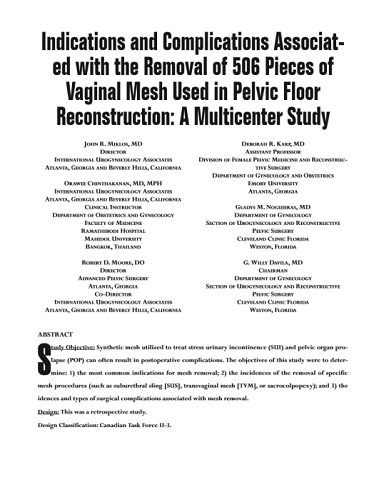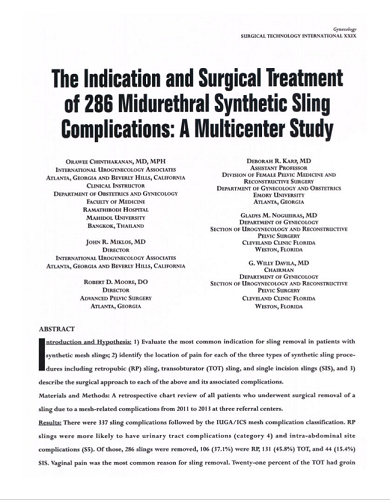WHAT ARE THE SIGNS AND SYMPTOMS OF BLADDER SLING COMPLICATIONS?
When patients and surgeons talk about bladder slings, they are primarily speaking of slings for the urethra to stop stress urinary incontinence (SUI) or leakage due to cough and sneezing. The slings most utilized for stopping SUI are the TVT, TOT and single incision slings. (See below)
Complications which can occur after placing the mesh sling include:
Chronic Pain– is one of the most common complications of transvaginal mesh surgery. Pain can be caused by nerve damage, mesh erosion into neighboring organs such as: bladder, urethra, small or large bowel or most commonly the vaginal skin or excessive scar tissue which can pull on the nerve laden muscle fascial layer.
Painful Sex – mesh can cause painful intercourse for the patient and / or her partner. Again, the scar tissue can cause pain and pain often results in difficulty enjoying intimacy and can results in the inability to orgasm.
Groin Pain (aka inguinal pain) – patients with TOT slings can have pain in the groin (inguinal region) or the area supplied by the obturator nerve of one or both legs. This can occur if the mesh has been placed in too tightly or the mesh tightens too much due to inflammation. Excessive scar tissues will cause the mesh to contract and then the mesh pulls on the obturator muscles and nerves resulting in groin and/or inner thigh pain. (Video 1)
Pelvic or Lower abdominal pain – the TVT and the TOT mesh slings can cause pain in the lower abdomen or pelvis. Again, the pain is the result of the inflammatory reaction to the mesh which creates scar tissue. This scar causes mesh contraction and often pain will be created along the pathway of the mesh sling. Pain can be reduced by removing the sling in the area of the pain. If the pain is isolated to the vagina, then we recommend only removing the vaginal portion of the mesh. However, if the patient has lower abdominal/pelvic pain or pubic pain then it is recommended to remove the arms of the mesh which are anchored into the abdominal muscles near the pubic bone. (Video 2)
Urethral pain with or without intercourse – if the patient is only experiencing pain near the urethra after sling insertion, the patient will most likely benefit from removing the sling near the urethra. It has been Miklos & Moore experience that it is best to remove the vaginal portion of the sling which usually measure approximately 5-6 cm in length once removed.
Urine retention without vaginal, pelvic pain – urine retention after any sling will require a loosening or a revision (cutting) or removal of the vaginal portion of the sling. Removal of the obstructive portion of the sling, ie. the urethral portion should allow the patient to completely empty their bladder.
Infection – which may result in tissue or organ wall infection which can manifest as a symptom of pain, fever, discharge.
Vaginal bleeding – is usually due to exposed mesh which is rubbing and irritating the vaginal skin.
Vaginal discharge – this can be due to continual irritation of the vaginal skin by the mesh, an infection or a sinus tract.
Mesh exposure – transvaginal mesh can become exposed so one can see the mesh coming through the vaginal skin, this can cause pain, painful intercourse for the patient and her partner as well as bleeding and infection.
Mesh erosion – is like mesh exposure however instead of the mesh migrating or being seen on the outside i.e., as a disruption in the skin of the vagina one would see the mesh penetrating the inside of a neighboring organ such as the urethra, bladder, or rectum. When this happens common signs or symptoms include pain, bleeding, infection, painful intercourse or potentially blood in the urine or in the feces and pain during urination or defecation.
Urinary problems – may include complete urine retention, the inability to empty one’s bladder, urgency, frequency, overactive bladder, recurrent urinary tract infections or urinary incontinence. The mesh can cause urinary problems, such as urinary incontinence, urinary retention, and urinary tract infections.
Video 1
TVT removal for Obturator pain
Video 2
TVT removal for Pubic pain
WHY CHOOSE MIKLOS & MOORE UROGYNECOLOGY TO SOLVE YOUR BLADDER SLING COMPLICATIONS?
Dr. Miklos is a highly experienced and skilled surgeon who specializes in the treatment of mesh complications. He has removed more than 1,000 pieces of mesh and has been removing mesh since 1994. Few surgeons in the world can make this claim. He has also written one of the largest papers in the world on mesh sling complications and their surgical removal, 286 sling removals in approximately 3 years. (Figure 1) In this paper, Dr. Miklos removed approximately 80% of the slings.
Dr. Miklos has a patient-centered approach to care as he listens to the patient’s point of view and her description of her symptoms. Often these symptoms are not always supported by the scientific literature. He takes the time to thoroughly evaluate each patient’s unique situation and develop a personalized treatment plan and make recommendations but allows each patient to make the final decision as to the surgery and technique. He truly believes that he makes the patient an informed consumer so she can ultimately make the right decision to minimize or stop her pain and suffering. Overall, choosing Dr. Miklos for your mesh complication surgery can provide you with the expert care and support you need to achieve the best possible outcome. Dr Miklos has:
EXPERIENCE -First and foremost at Miklos & Moore Urogynecology the doctors listen. They have been removing mesh since 1998 and have seen, treated, or removed just about every type of transvaginal mesh complication known to man. They have removed more than 1000 pieces of mesh with minimal complications and superior success. They have written the largest vaginal mesh complication paper (FIGURE 2) and the largest sling complication surgical paper in the USA of which Dr Miklos removed 80% of the mesh.
EXPERTISE – They have treated patients from all over the world for mesh complications. They have produced award-winning videos which have garnered them international acclaim for their mesh-removing technique. Dr. Miklos has taught post-graduate courses for mesh removal at conferences in USA, South Africa, Europe, South America and the UK.
KNOWLEDGE – They are Rule 26 medical legal experts who understand the law and malpractice cases facing patients today. They are also leaders in the world on mesh complications as they have written some of the largest papers on mesh complications found in the worldwide literature.
RESULTS – Miklos & Moore Urogynecology have addressed and removed some of the most difficult transvaginal mesh devices made and inserted in the human body. Though no one can guarantee the success rate for fixing the patient’s symptoms, Dr Miklos can usually remove >95% of the mesh load > 90% of the time. He can totally remove the complete implant most of the time it is indicated.
Here at Miklos & Moore Urogynecology, we have removed 100s of TVT, TOT and single incision slings. They have the ability to remove the total sling, when necessary, especially in patients with chronic pelvic, pain, painful pelvis, autoimmune disorders or fistulas.
RECOVERY TIME AFTER BLADDER SLING REMOVAL SURGERY?
The recovery time after bladder sling removal surgery depends upon the actual type of sling placed and the surgical removal procedure. However, whether removing a TVT, TOT or a single incision sling most patients are discharged 24 hours after surgery. We can essentially categorize the recovery based upon 2 different types of sling removal.
- Sling incision or partial removal. These patients only have one incision under the urethra of approximately 2 cm. After the mesh is either cut of removed, a suture is used to close this 2 cm incision. Usually, the mesh sling is cut or partially removed for urine retention of painful intercourse. This procedure can be done as an outpatient and there is usually very little pain involved. The patients can return to work the next day but are restricted from intercourse for 4 weeks.
- Total Sling removal – requires a transvaginal sling removal via the vagina and then other incisions in the groin for TOT sling removal or in the abdomen for a TVT sling removal. These patients usually have total recovery within 6 weeks and resume normal activity at that time. If the patient also receives reconstructive surgery like in the Video 2, ie Burch and paravaginal repair, we recommend 12 weeks of pelvic rest after the surgery.



